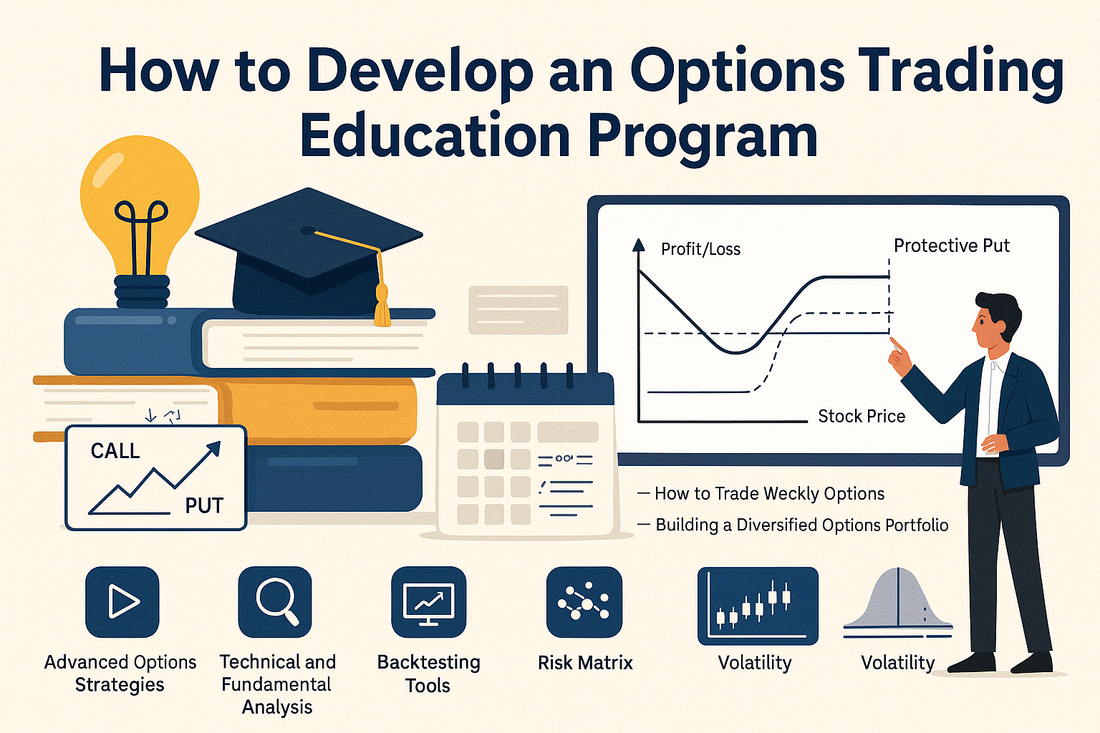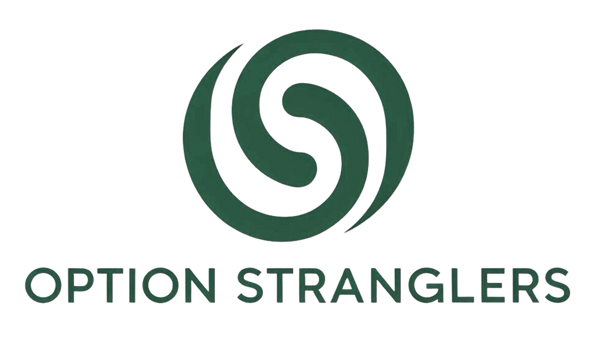
How to Develop an Options Trading Education Program
Introduction: Why Build an Options Trading Education Program?
Options trading offers unmatched flexibility, leverage, and income potential—if you know how to use it. But for many new traders, the steep learning curve can be intimidating. Terms like “iron condor,” “theta decay,” and “delta hedging” often seem like a foreign language.
That’s why developing a structured options trading education program is critical—whether you’re curating content for your blog, coaching a small mentorship group, or designing a full-fledged course. A well-crafted curriculum helps learners progress from zero to strategic confidence, while also promoting consistency, discipline, and long-term success.
In this article, we’ll outline a step-by-step guide to creating a powerful educational experience in options trading. We’ll cover how to plan the curriculum, what essential topics to include, and which tools and resources will amplify the learning experience.
This program isn’t just about teaching strategies—it’s about empowering people to achieve financial freedom and escape the rat race.
1. Curriculum Planning: Building the Foundation
Before diving into technical lessons and trade setups, you need to define your target audience, desired outcomes, and the instructional structure.
1.1 Define the Objective
Begin with a clear goal:
- Is it to create beginner-friendly blog content?
- A structured video course?
- An interactive mentorship experience?
Your educational content should be aligned with the stage of your audience. For example:
- Beginners: Need foundational knowledge, terminology, and basic trade types.
- Intermediate Traders: Seek strategy frameworks, technical tools, and trade management.
- Advanced Learners: Want in-depth volatility modeling, complex spreads, and portfolio-level thinking.
1.2 Determine the Format
Your format can influence how learners absorb and retain knowledge. Common educational formats include:
- Blog series or written guides
- PDF handbooks and eBooks
- Interactive webinars
- Video courses and screen recordings
- One-on-one mentorship
- Group classes or coaching cohorts
- Telegram or Discord communities for engagement
🔗 See how our mentorship program works
1.3 Segment the Learning Path
Use a modular structure that guides learners from foundational knowledge to more advanced concepts.
For example:
- Module 1: Introduction to Options
- Module 2: Core Terminology and Market Mechanics
- Module 3: Simple Options Strategies (Covered Calls, Cash-Secured Puts)
- Module 4: Intermediate Spreads (Verticals, Straddles, Strangles)
- Module 5: Advanced Tactics (Iron Condors, Calendar Spreads, Hedging)
- Module 6: Trade Journaling and Mindset
- Module 7: Live Trade Walkthroughs
- Module 8: Risk Management and Portfolio Construction
2. Key Topics to Cover in the Education Program
Each topic in your curriculum should build on the last, reinforcing understanding through practical examples, visual aids, and trade simulations.
2.1 Options Basics
- What are Options?
- Calls vs. Puts
- American vs. European-style options
- Strike price, premium, and expiration
- Intrinsic and extrinsic value
🔗 Read: Options Trading Terminology: A Comprehensive Glossary
2.2 The Greeks
- Delta, Gamma, Theta, Vega, Rho
- Real-world implications of the Greeks on open trades
- Using Greeks to manage positions and forecast risk
🔗 Creating and Interpreting Options Volatility Skews
2.3 Simple Strategies for Beginners
- Covered Calls
- Cash-Secured Puts
- Protective Puts
- Buy-Writes
- Using options for dividend capture
2.4 Intermediate Strategies
- Vertical Spreads (credit/debit)
- Iron Condors
- Straddles and Strangles
- Ratio Spreads
- Calendar and Diagonal Spreads
Include trade examples using SPY, QQQ, AAPL, or NVDA—liquid and highly traded names.
2.5 Advanced Concepts
- Hedging entire portfolios
- Vega-neutral strategies
- Multi-leg order management
- Managing theta decay
- Understanding volatility crush during earnings
🔗 Options Trading During Earnings Season
2.6 Technical & Fundamental Analysis
- Chart patterns, support/resistance
- Volume and momentum indicators (MACD, RSI, Bollinger Bands)
- Earnings reports and news flow impact
- Combining TA and FA with options setups
🔗 Technical Indicators for Entry and Exit Points
2.7 Trading Psychology
- Emotional discipline
- Avoiding revenge trading
- Overcoming fear and greed
- Building a growth mindset
🔗 Read: The Psychology of Trading
2.8 Risk Management and Journaling
- Risk-to-reward analysis
- Position sizing
- Diversification using uncorrelated strategies
- Keeping a trading journal to track wins, losses, and lessons
🔗 Managing Your Options Trading Journal
3. Tools and Resources: Amplifying the Learning Experience
A quality options education program isn’t just about knowledge—it’s about access to tools that help learners apply that knowledge effectively.
3.1 Paper Trading Platforms
Simulated trading builds confidence without financial risk. Some platforms include:
- ThinkOrSwim (TD Ameritrade) – PaperMoney for real-time simulations
- Tastytrade – Great for multi-leg orders and analysis
- Interactive Brokers – Extensive options capabilities
- OptionsStranglers' Paper Trade Tracker Template – Customized journal to simulate real trades
🔗 The Benefits of Paper Trading for Options Traders
3.2 Backtesting Software
Teach students how to test strategies historically to verify validity:
- OptionNet Explorer
- ORATS
- QuantConnect (for coders)
- Excel (for manual tracking)
🔗 How to Use Backtesting Software for Options Strategies
3.3 Visualization and Illustration Tools
Use flowcharts, screenshots, and diagrams to simplify abstract ideas:
- TradingView or ThinkOrSwim screenshots
- Risk/reward graphs
- Equity curves and heatmaps
- Option payoff diagrams
🧭 Illustration: Education Program Flowchart

3.4 Engagement and Community
Provide students with a way to stay engaged, ask questions, and share insights:
- Telegram or Discord discussion groups
- Weekly Q&A sessions
- Trade of the week discussion
- Guest speakers and trader interviews
🔗 Explore our Telegram Community
3.5 Tools for Instructors
If you’re building a formal program, use tools that help scale delivery:
- LMS platforms: Thinkific, Teachable, Kajabi
- Zoom or Google Meet: For live sessions
- Canva: To create slides and visuals
- Google Sheets/Excel: For trade tracking and journaling templates
4. Structuring a 4–8 Week Options Education Program (Example)
Here’s a sample curriculum layout for a structured weekly learning path:
Week 1: Options Basics
- What are options?
- Call vs. put
- Contract specs
- Demo video on buying a call
Week 2: Understanding the Greeks
- Delta, Gamma, Theta, Vega
- Volatility sensitivity
- Homework: Calculate Greeks on SPY options
Week 3: Simple Strategies
- Covered Calls and Cash-Secured Puts
- Demo: Live trade setup
- Assignment: Find 3 viable trade ideas
Week 4: Intermediate Spreads
- Vertical spreads, Iron Condors
- Risk/reward visualization
- Class trade walkthrough
Week 5: Technical + Fundamental Triggers
- RSI/MACD setups
- Earnings-based options
- Practice: Simulate earnings trade
Week 6: Advanced Strategies + Hedging
- Calendar spreads, ratio spreads
- Managing volatility crush
- Hedging long equity
Week 7: Trade Journaling + Risk Management
- Logging trades
- Reviewing setups
- Group critique of trade journals
Week 8: Live Trade Simulation + Q&A
- Students set up paper trades live
- Real-time feedback
- Discussion on next steps
Final Tips for Educators and Coaches
- Always anchor concepts in real examples
- Use repeatable checklists and frameworks
- Offer downloadable templates and trackers
- Encourage peer-to-peer discussion
- Provide post-course access to continue learning
An effective options education program is about more than strategies. It’s about developing self-reliance, pattern recognition, and a trader’s mindset.
📣 Interested to know more?
At www.optionstranglers.com.sg we offer:
- ✅ In-depth live 1-1 sessions / group classes
- 📈 Real trade examples and breakdowns
- 🤝 Community mentorship and support
👉 Ready to upgrade your strategy and trade like a pro? Visit www.optionstranglers.com.sg and start your journey to financial freedom today.
Your future is an option. Choose wisely.
⚠️ Disclaimer:
Options involve risk and are not suitable for all investors. Always consult with a financial advisor before investing.
